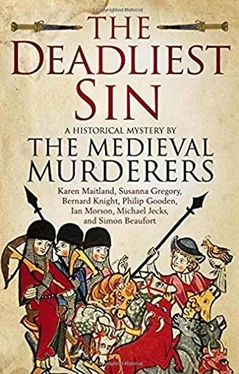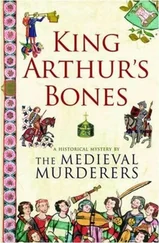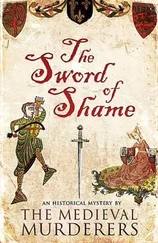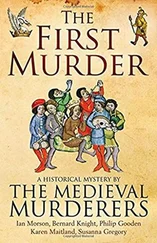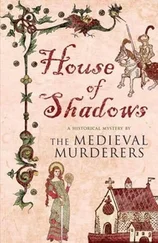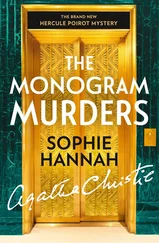‘The seeds did not kill them,’ Matthew replied. ‘It was the substance around them that conveyed the poison, though that was originally made from the seeds.’ He sat on the edge of a box in the storeroom. ‘Look, everyone knows – certainly all country folk – that the yew tree is very dangerous. Branches lopped from yew are never left on the ground, because if livestock eat them, they may well die. All parts of the yew contain this poison, except the pulp of the berries. Yet the tiny seeds in the centre of the berries is very poisonous indeed!’
William still failed to see where this lecture was going. ‘So what killed the rats and the others?’
The apothecary patiently continued his explanation. ‘I gave the rats some scrapings from inside the boots and on the hose – it was virtually a paste, but that was because the rotten skin of the beggar, together with dirt from his feet and sweat, had probably softened what I suspect was originally a dry powder made from pounding a large number of seeds extracted from yew berries.’
William was still confused. ‘But how could that kill a man – in fact, two men, if you count the beggar?’
‘In my profession, we very often apply our medicaments through the skin – apart from giving cures by mouth, that is about the only other route available, other than by a clister through the back passage. Rubbed into the skin, especially with some kind of fatty base, some of the drug gets absorbed into the body.’
William Hangfield frowned as he digested this information. ‘So someone would have to sprinkle the powdered yew seeds into the boots and hose undetected, if he – or she – wanted to cause harm to the victim?’
Matthew nodded his agreement. ‘It would be a brownish colour and as the clothing was the same hue, it might well go unnoticed.’
‘Would this be effective in a single dose or would the effect only work over a long period?
‘I have seen two cases of yew poisoning in my lifetime, both in children who ate the attractive berries. Thankfully, both survived after forced vomiting and energetic purging, but they became very ill within a few hours, again with twitching and fits and a very irregular pulse. So a single large dose can kill quickly, but I doubt that could be achieved through the skin, so a more long-term application would be needed, which could build up to dangerous or fatal levels.’
William had by now grasped all the essentials of the method of killing, but the vital question now remained – who was responsible? He had one last question for the apothecary.
‘The previous illness, which cleared up when he left the house for London – have you any idea what that might have been?’
Matthew considered this for a moment.
‘It was certainly not the yew poison. He had an obvious excess of bile in his system and there are a number of poisons obtainable from plants in the hedgerows and woods that would do that. I would suggest it might have been an extract of ragwort, that tall yellow weed that grows everywhere. That sometimes kills horses and asses, even when they merely eat hay that contains the dried plant – but there is no way of being certain.’
William thanked Matthew Herbert sincerely for his help and asked him to keep the evidence safe until he knew how the coroner wanted to proceed. It was about time he told Ralph fitz Urse that the investigation had been revived, so he trudged back to the castle with the news.
As luck would have it – though possibly bad luck – he found the sheriff in the coroner’s chamber, sharing a jug of red Anjou wine as they chewed over the latest news of King Edward’s problems. It was not long since the humiliating defeat at the battle at Boroughbridge and though Bristol was a royal stronghold, the tide was turning against him, mainly from the Scots and his own barons, though even his wife was beginning to lose patience with her husband’s infatuation with the Despensers, both father and son.
The two men were arguing about the prospects of war when William came in, and he had some difficulty in bringing them back to the problems of the immediate present.
‘I know how Robert Giffard was murdered, sirs,’ he announced as soon as he had managed to get their attention. ‘But I have no idea who did it!’
Nicholas Cheyney stared at him as if he had suddenly lost his wits and the coroner glared at him ferociously.
‘What are you talking about?’ he barked. ‘We’ll never know what happened to Giffard. There’s nothing left to discover.’
His officer tried to keep a smug expression from his face. ‘But I’ve just discovered it, sir. He had poison put in his boots and hose!’
‘In his boots!’ yelled the sheriff. ‘Are you quite mad, William Hangfield?’
Hurriedly, the serjeant explained, before the others had apoplexy. He told them the whole story of the beggar, the dead rats and his involvement of Matthew the apothecary.
‘He says there’s no doubt about the yew being the poison, and though he has never heard of it being used through the skin, there is no medical reason why it shouldn’t work.’
Eventually, the two senior men grudgingly accepted that the officer was neither mad nor playing some inexplicable practical joke.
‘We must hear this from Matthew Herbert’s own mouth,’ growled the coroner. ‘Then discover who the culprit must be.’
‘It has to be someone in the Giffard household,’ snapped the sheriff. ‘No one else would have access to either his boots or, in the previous suspected poisoning, to his food.’
‘And it must be someone who knows a great deal about yew poison and how it could be absorbed through the skin,’ added William, sagely.
‘That servant who acts as an apothecary fits the bill best,’ grated the sheriff. ‘What was his name, Stogursey or some such?’
‘Remember that the lady Eleanor had the same access to his food and his boots,’ objected fitz Urse. ‘And there is this suspicion that she might be carrying on with Jordan fitz Hamon.’
‘But she would not have enough knowledge of poisons to pull off this yew-in-the-boots trick,’ scoffed Nicholas Cheyney, always ready to contradict the coroner.
Again, William threw in a reasonable contribution. ‘The one who knew about the yew seeds and was able to prepare them need not be one who actually administered them, sirs.’
The other two digested this for a moment. ‘If so, then even Jordan fitz Hamon could be behind the murderous plot!’ said the coroner.
The sheriff, who was ultimately responsible for law and order in the county of Somerset, turned to William with new orders.
‘We need to shake the tree of the Giffard household and see what falls out. Take a couple of men-at-arms with you and get to the truth of this affair, even if you threaten them with torture.’
Hangfield sincerely hoped it would not come to that, but he touched his forehead respectfully and left to carry out his orders.
At the house in King Street, he sought an audience with Mistress Eleanor, brushing aside any delaying tactics by Edward Stogursey. She was in the doctor’s chamber with the new physician, a pleasant-looking man of about thirty, but William, invoking the command of the sheriff, asked her to step into an empty living-room nearby.
‘Madam, we have now discovered how your husband died – he was murdered by the poison from yew berries,’ he announced bluntly. ‘The deadly substance could only have been administered by someone in this household – and his previous illness in February may have been from putting a tincture made from ragwort in his food, again obviously by someone in the house.’
The new widow paled and clutched at her throat in a typically feminine gesture of shock. ‘Are you sure of this? Who could have done such a terrible thing?’
Читать дальше
